Exploring Energy's Impact on the United Nations' SDGs Agenda 2030
VerifiedAdded on 2023/06/03
|9
|2595
|180
Essay
AI Summary
This essay explores the critical role of energy, particularly through Sustainable Development Goal 7 (SDG 7), in achieving the broader Agenda 2030 for Sustainable Development, adopted by the United Nations. It highlights the interconnectedness of energy with other SDGs, such as poverty reduction, health, education, and climate action. The essay emphasizes the importance of transitioning to clean, affordable, and reliable energy sources to ensure a sustainable future, addresses the challenges in achieving SDG 7, including the need for increased financing, policy changes, and technological advancements, and stresses the urgency of global cooperation and willingness to embrace renewable energy technologies to mitigate climate change and secure a sustainable environment for future generations. The document / assignment is contributed by a student to be published on the website Desklib. Desklib is a platform which provides all the necessary AI based study tools for students.
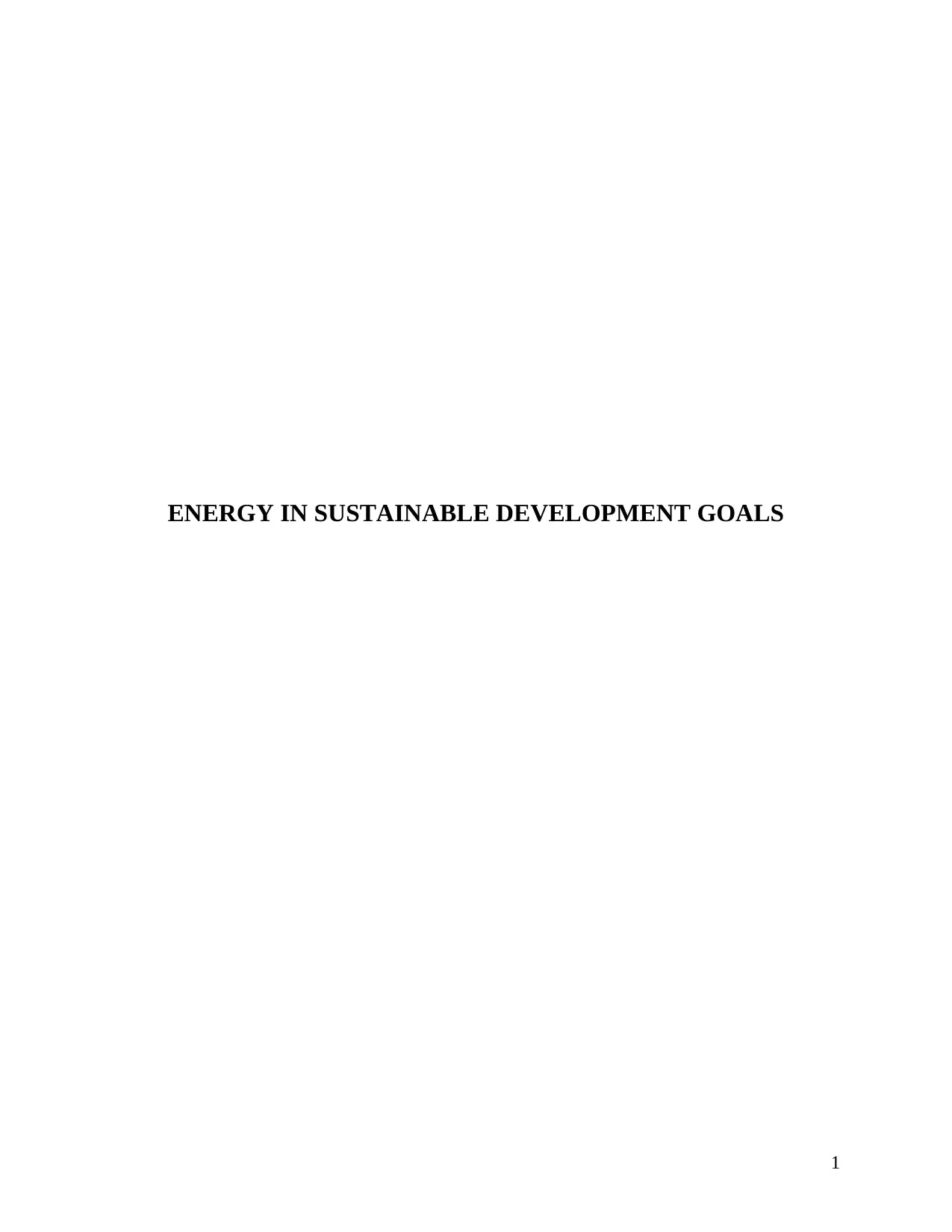
ENERGY IN SUSTAINABLE DEVELOPMENT GOALS
1
1
Paraphrase This Document
Need a fresh take? Get an instant paraphrase of this document with our AI Paraphraser
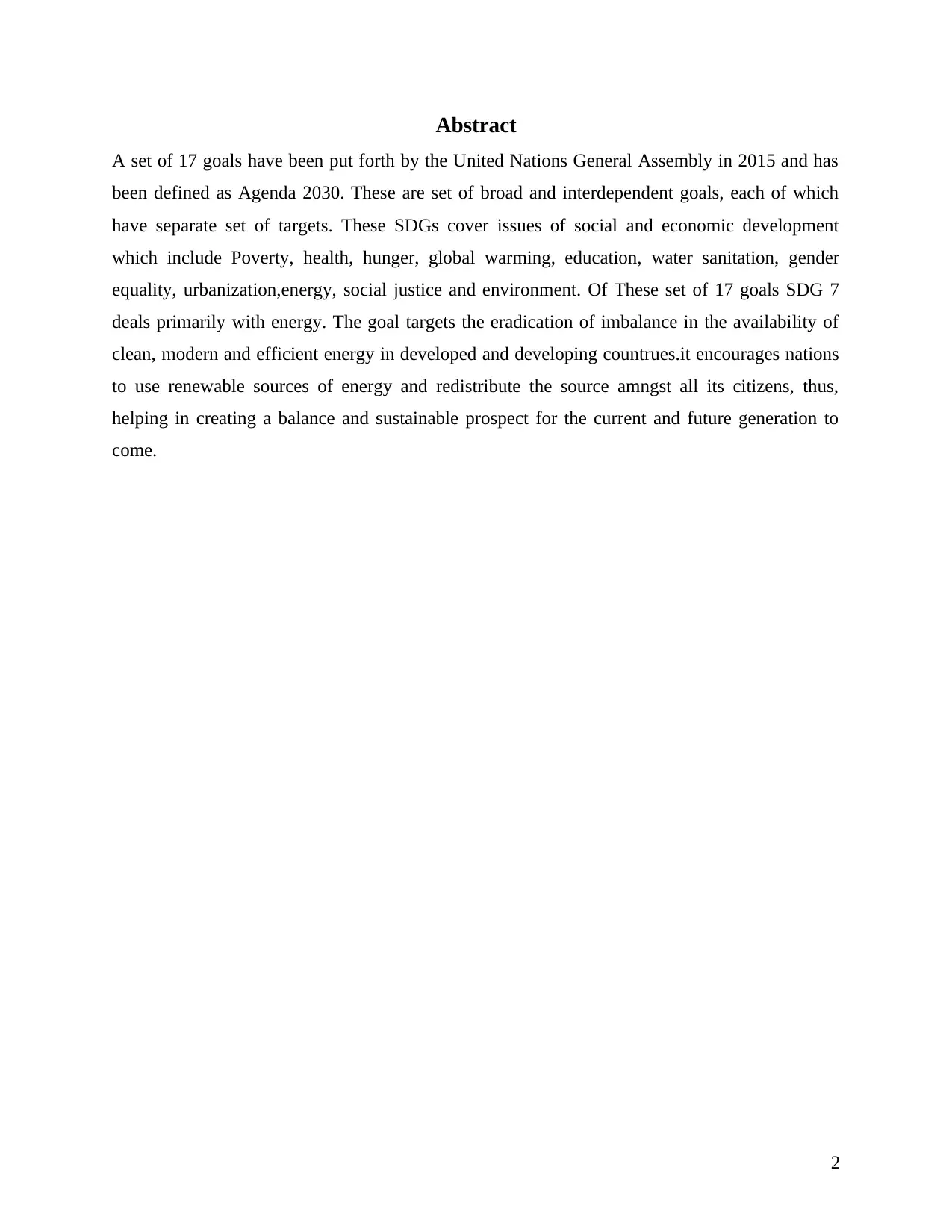
Abstract
A set of 17 goals have been put forth by the United Nations General Assembly in 2015 and has
been defined as Agenda 2030. These are set of broad and interdependent goals, each of which
have separate set of targets. These SDGs cover issues of social and economic development
which include Poverty, health, hunger, global warming, education, water sanitation, gender
equality, urbanization,energy, social justice and environment. Of These set of 17 goals SDG 7
deals primarily with energy. The goal targets the eradication of imbalance in the availability of
clean, modern and efficient energy in developed and developing countrues.it encourages nations
to use renewable sources of energy and redistribute the source amngst all its citizens, thus,
helping in creating a balance and sustainable prospect for the current and future generation to
come.
2
A set of 17 goals have been put forth by the United Nations General Assembly in 2015 and has
been defined as Agenda 2030. These are set of broad and interdependent goals, each of which
have separate set of targets. These SDGs cover issues of social and economic development
which include Poverty, health, hunger, global warming, education, water sanitation, gender
equality, urbanization,energy, social justice and environment. Of These set of 17 goals SDG 7
deals primarily with energy. The goal targets the eradication of imbalance in the availability of
clean, modern and efficient energy in developed and developing countrues.it encourages nations
to use renewable sources of energy and redistribute the source amngst all its citizens, thus,
helping in creating a balance and sustainable prospect for the current and future generation to
come.
2
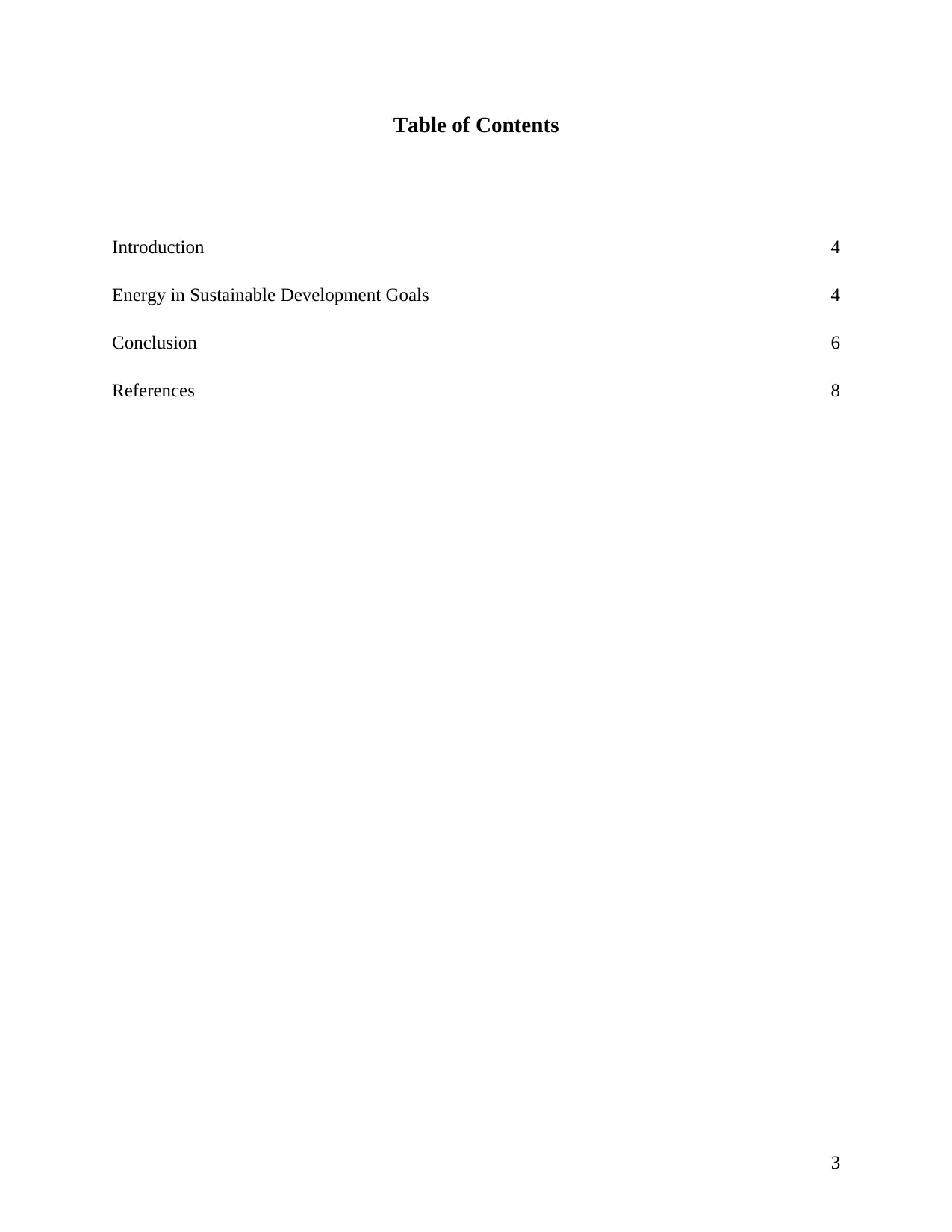
Table of Contents
Introduction 4
Energy in Sustainable Development Goals 4
Conclusion 6
References 8
3
Introduction 4
Energy in Sustainable Development Goals 4
Conclusion 6
References 8
3
⊘ This is a preview!⊘
Do you want full access?
Subscribe today to unlock all pages.

Trusted by 1+ million students worldwide
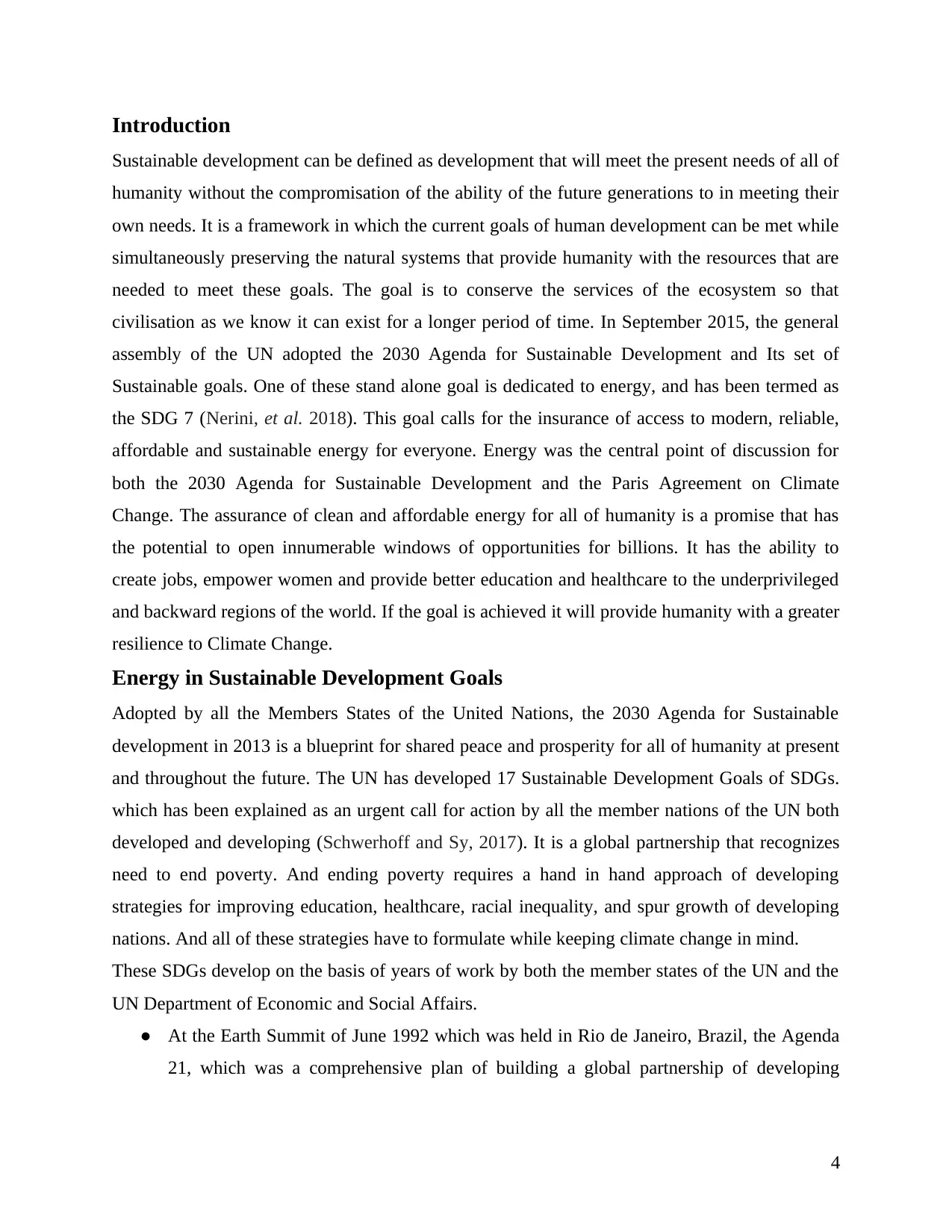
Introduction
Sustainable development can be defined as development that will meet the present needs of all of
humanity without the compromisation of the ability of the future generations to in meeting their
own needs. It is a framework in which the current goals of human development can be met while
simultaneously preserving the natural systems that provide humanity with the resources that are
needed to meet these goals. The goal is to conserve the services of the ecosystem so that
civilisation as we know it can exist for a longer period of time. In September 2015, the general
assembly of the UN adopted the 2030 Agenda for Sustainable Development and Its set of
Sustainable goals. One of these stand alone goal is dedicated to energy, and has been termed as
the SDG 7 (Nerini, et al. 2018). This goal calls for the insurance of access to modern, reliable,
affordable and sustainable energy for everyone. Energy was the central point of discussion for
both the 2030 Agenda for Sustainable Development and the Paris Agreement on Climate
Change. The assurance of clean and affordable energy for all of humanity is a promise that has
the potential to open innumerable windows of opportunities for billions. It has the ability to
create jobs, empower women and provide better education and healthcare to the underprivileged
and backward regions of the world. If the goal is achieved it will provide humanity with a greater
resilience to Climate Change.
Energy in Sustainable Development Goals
Adopted by all the Members States of the United Nations, the 2030 Agenda for Sustainable
development in 2013 is a blueprint for shared peace and prosperity for all of humanity at present
and throughout the future. The UN has developed 17 Sustainable Development Goals of SDGs.
which has been explained as an urgent call for action by all the member nations of the UN both
developed and developing (Schwerhoff and Sy, 2017). It is a global partnership that recognizes
need to end poverty. And ending poverty requires a hand in hand approach of developing
strategies for improving education, healthcare, racial inequality, and spur growth of developing
nations. And all of these strategies have to formulate while keeping climate change in mind.
These SDGs develop on the basis of years of work by both the member states of the UN and the
UN Department of Economic and Social Affairs.
● At the Earth Summit of June 1992 which was held in Rio de Janeiro, Brazil, the Agenda
21, which was a comprehensive plan of building a global partnership of developing
4
Sustainable development can be defined as development that will meet the present needs of all of
humanity without the compromisation of the ability of the future generations to in meeting their
own needs. It is a framework in which the current goals of human development can be met while
simultaneously preserving the natural systems that provide humanity with the resources that are
needed to meet these goals. The goal is to conserve the services of the ecosystem so that
civilisation as we know it can exist for a longer period of time. In September 2015, the general
assembly of the UN adopted the 2030 Agenda for Sustainable Development and Its set of
Sustainable goals. One of these stand alone goal is dedicated to energy, and has been termed as
the SDG 7 (Nerini, et al. 2018). This goal calls for the insurance of access to modern, reliable,
affordable and sustainable energy for everyone. Energy was the central point of discussion for
both the 2030 Agenda for Sustainable Development and the Paris Agreement on Climate
Change. The assurance of clean and affordable energy for all of humanity is a promise that has
the potential to open innumerable windows of opportunities for billions. It has the ability to
create jobs, empower women and provide better education and healthcare to the underprivileged
and backward regions of the world. If the goal is achieved it will provide humanity with a greater
resilience to Climate Change.
Energy in Sustainable Development Goals
Adopted by all the Members States of the United Nations, the 2030 Agenda for Sustainable
development in 2013 is a blueprint for shared peace and prosperity for all of humanity at present
and throughout the future. The UN has developed 17 Sustainable Development Goals of SDGs.
which has been explained as an urgent call for action by all the member nations of the UN both
developed and developing (Schwerhoff and Sy, 2017). It is a global partnership that recognizes
need to end poverty. And ending poverty requires a hand in hand approach of developing
strategies for improving education, healthcare, racial inequality, and spur growth of developing
nations. And all of these strategies have to formulate while keeping climate change in mind.
These SDGs develop on the basis of years of work by both the member states of the UN and the
UN Department of Economic and Social Affairs.
● At the Earth Summit of June 1992 which was held in Rio de Janeiro, Brazil, the Agenda
21, which was a comprehensive plan of building a global partnership of developing
4
Paraphrase This Document
Need a fresh take? Get an instant paraphrase of this document with our AI Paraphraser
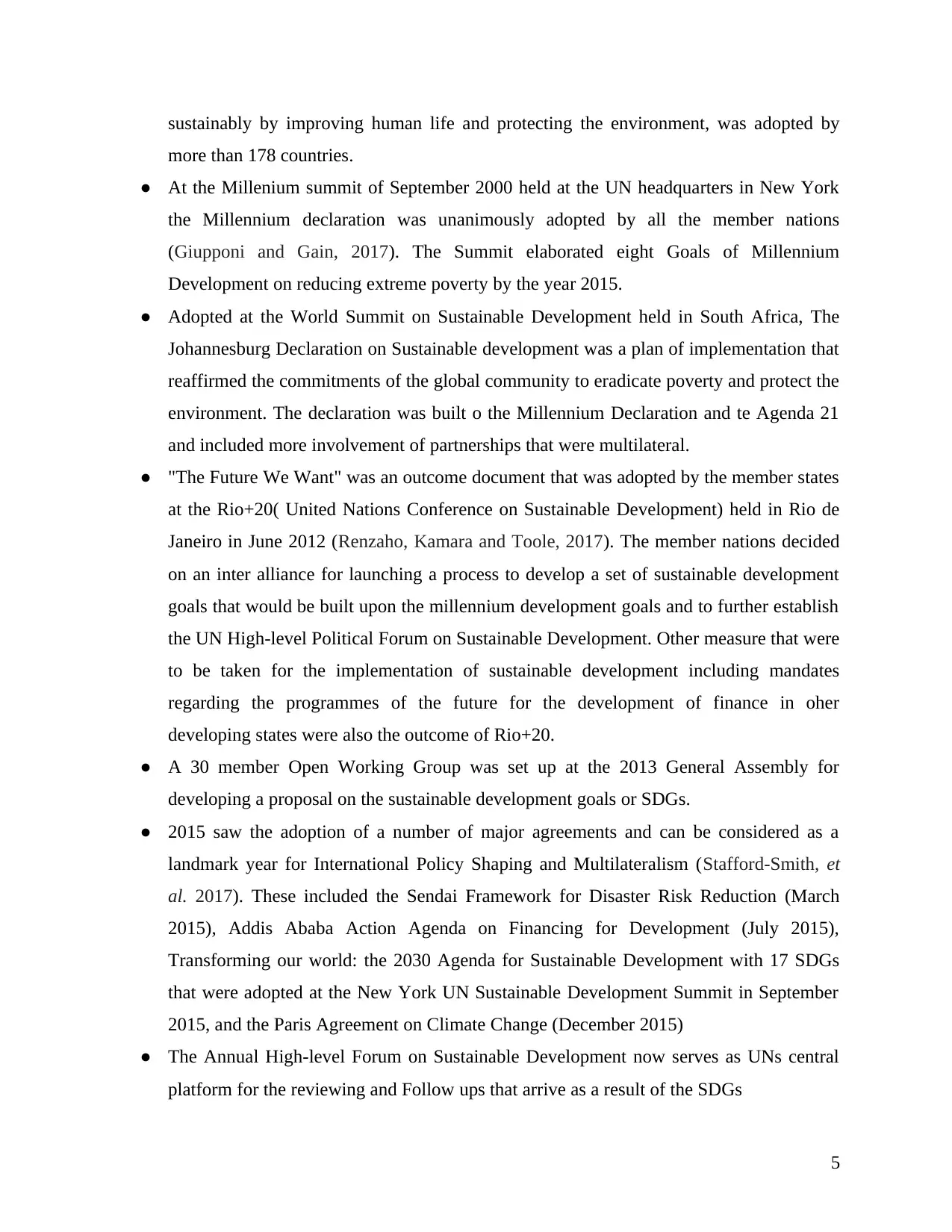
sustainably by improving human life and protecting the environment, was adopted by
more than 178 countries.
● At the Millenium summit of September 2000 held at the UN headquarters in New York
the Millennium declaration was unanimously adopted by all the member nations
(Giupponi and Gain, 2017). The Summit elaborated eight Goals of Millennium
Development on reducing extreme poverty by the year 2015.
● Adopted at the World Summit on Sustainable Development held in South Africa, The
Johannesburg Declaration on Sustainable development was a plan of implementation that
reaffirmed the commitments of the global community to eradicate poverty and protect the
environment. The declaration was built o the Millennium Declaration and te Agenda 21
and included more involvement of partnerships that were multilateral.
● "The Future We Want" was an outcome document that was adopted by the member states
at the Rio+20( United Nations Conference on Sustainable Development) held in Rio de
Janeiro in June 2012 (Renzaho, Kamara and Toole, 2017). The member nations decided
on an inter alliance for launching a process to develop a set of sustainable development
goals that would be built upon the millennium development goals and to further establish
the UN High-level Political Forum on Sustainable Development. Other measure that were
to be taken for the implementation of sustainable development including mandates
regarding the programmes of the future for the development of finance in oher
developing states were also the outcome of Rio+20.
● A 30 member Open Working Group was set up at the 2013 General Assembly for
developing a proposal on the sustainable development goals or SDGs.
● 2015 saw the adoption of a number of major agreements and can be considered as a
landmark year for International Policy Shaping and Multilateralism (Stafford-Smith, et
al. 2017). These included the Sendai Framework for Disaster Risk Reduction (March
2015), Addis Ababa Action Agenda on Financing for Development (July 2015),
Transforming our world: the 2030 Agenda for Sustainable Development with 17 SDGs
that were adopted at the New York UN Sustainable Development Summit in September
2015, and the Paris Agreement on Climate Change (December 2015)
● The Annual High-level Forum on Sustainable Development now serves as UNs central
platform for the reviewing and Follow ups that arrive as a result of the SDGs
5
more than 178 countries.
● At the Millenium summit of September 2000 held at the UN headquarters in New York
the Millennium declaration was unanimously adopted by all the member nations
(Giupponi and Gain, 2017). The Summit elaborated eight Goals of Millennium
Development on reducing extreme poverty by the year 2015.
● Adopted at the World Summit on Sustainable Development held in South Africa, The
Johannesburg Declaration on Sustainable development was a plan of implementation that
reaffirmed the commitments of the global community to eradicate poverty and protect the
environment. The declaration was built o the Millennium Declaration and te Agenda 21
and included more involvement of partnerships that were multilateral.
● "The Future We Want" was an outcome document that was adopted by the member states
at the Rio+20( United Nations Conference on Sustainable Development) held in Rio de
Janeiro in June 2012 (Renzaho, Kamara and Toole, 2017). The member nations decided
on an inter alliance for launching a process to develop a set of sustainable development
goals that would be built upon the millennium development goals and to further establish
the UN High-level Political Forum on Sustainable Development. Other measure that were
to be taken for the implementation of sustainable development including mandates
regarding the programmes of the future for the development of finance in oher
developing states were also the outcome of Rio+20.
● A 30 member Open Working Group was set up at the 2013 General Assembly for
developing a proposal on the sustainable development goals or SDGs.
● 2015 saw the adoption of a number of major agreements and can be considered as a
landmark year for International Policy Shaping and Multilateralism (Stafford-Smith, et
al. 2017). These included the Sendai Framework for Disaster Risk Reduction (March
2015), Addis Ababa Action Agenda on Financing for Development (July 2015),
Transforming our world: the 2030 Agenda for Sustainable Development with 17 SDGs
that were adopted at the New York UN Sustainable Development Summit in September
2015, and the Paris Agreement on Climate Change (December 2015)
● The Annual High-level Forum on Sustainable Development now serves as UNs central
platform for the reviewing and Follow ups that arrive as a result of the SDGs
5
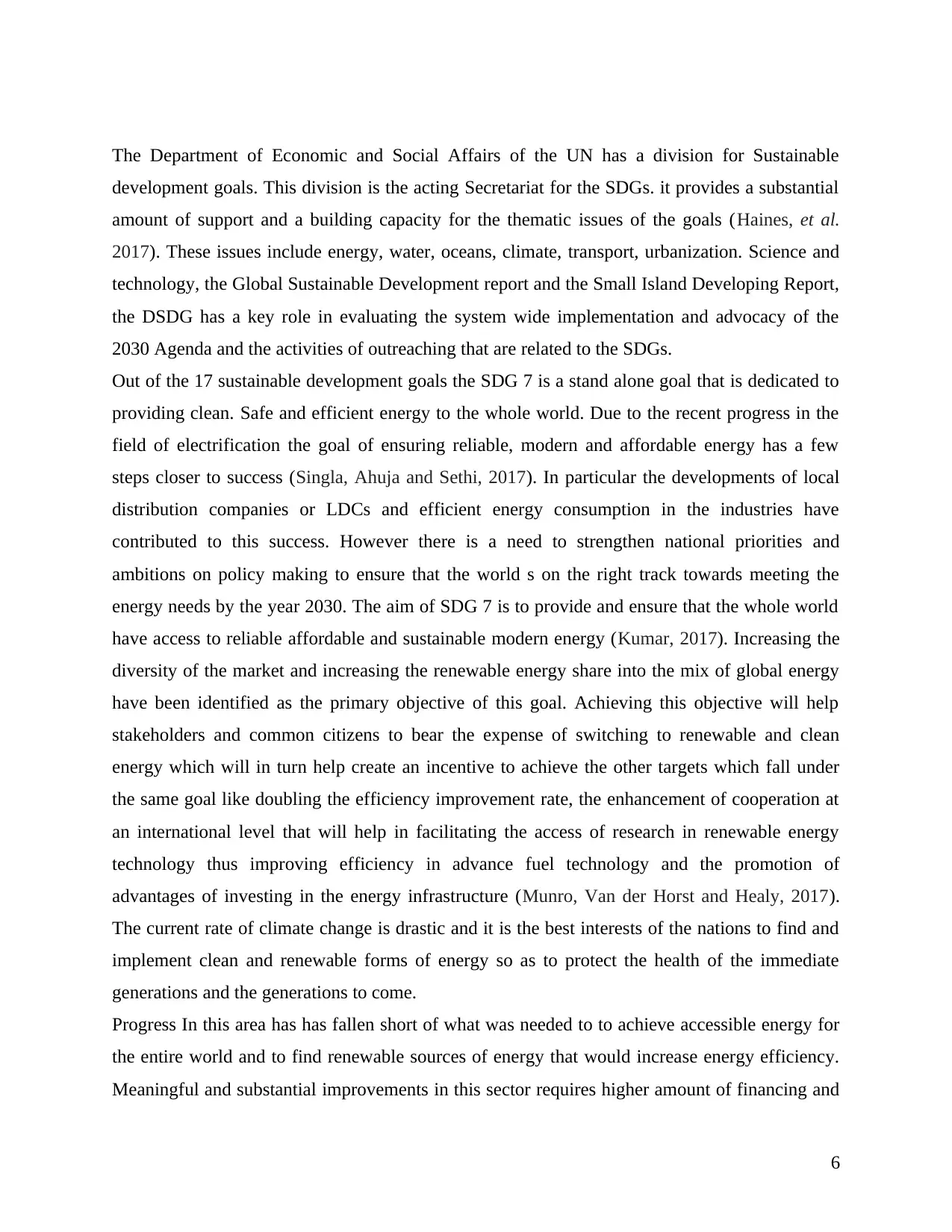
The Department of Economic and Social Affairs of the UN has a division for Sustainable
development goals. This division is the acting Secretariat for the SDGs. it provides a substantial
amount of support and a building capacity for the thematic issues of the goals (Haines, et al.
2017). These issues include energy, water, oceans, climate, transport, urbanization. Science and
technology, the Global Sustainable Development report and the Small Island Developing Report,
the DSDG has a key role in evaluating the system wide implementation and advocacy of the
2030 Agenda and the activities of outreaching that are related to the SDGs.
Out of the 17 sustainable development goals the SDG 7 is a stand alone goal that is dedicated to
providing clean. Safe and efficient energy to the whole world. Due to the recent progress in the
field of electrification the goal of ensuring reliable, modern and affordable energy has a few
steps closer to success (Singla, Ahuja and Sethi, 2017). In particular the developments of local
distribution companies or LDCs and efficient energy consumption in the industries have
contributed to this success. However there is a need to strengthen national priorities and
ambitions on policy making to ensure that the world s on the right track towards meeting the
energy needs by the year 2030. The aim of SDG 7 is to provide and ensure that the whole world
have access to reliable affordable and sustainable modern energy (Kumar, 2017). Increasing the
diversity of the market and increasing the renewable energy share into the mix of global energy
have been identified as the primary objective of this goal. Achieving this objective will help
stakeholders and common citizens to bear the expense of switching to renewable and clean
energy which will in turn help create an incentive to achieve the other targets which fall under
the same goal like doubling the efficiency improvement rate, the enhancement of cooperation at
an international level that will help in facilitating the access of research in renewable energy
technology thus improving efficiency in advance fuel technology and the promotion of
advantages of investing in the energy infrastructure (Munro, Van der Horst and Healy, 2017).
The current rate of climate change is drastic and it is the best interests of the nations to find and
implement clean and renewable forms of energy so as to protect the health of the immediate
generations and the generations to come.
Progress In this area has has fallen short of what was needed to to achieve accessible energy for
the entire world and to find renewable sources of energy that would increase energy efficiency.
Meaningful and substantial improvements in this sector requires higher amount of financing and
6
development goals. This division is the acting Secretariat for the SDGs. it provides a substantial
amount of support and a building capacity for the thematic issues of the goals (Haines, et al.
2017). These issues include energy, water, oceans, climate, transport, urbanization. Science and
technology, the Global Sustainable Development report and the Small Island Developing Report,
the DSDG has a key role in evaluating the system wide implementation and advocacy of the
2030 Agenda and the activities of outreaching that are related to the SDGs.
Out of the 17 sustainable development goals the SDG 7 is a stand alone goal that is dedicated to
providing clean. Safe and efficient energy to the whole world. Due to the recent progress in the
field of electrification the goal of ensuring reliable, modern and affordable energy has a few
steps closer to success (Singla, Ahuja and Sethi, 2017). In particular the developments of local
distribution companies or LDCs and efficient energy consumption in the industries have
contributed to this success. However there is a need to strengthen national priorities and
ambitions on policy making to ensure that the world s on the right track towards meeting the
energy needs by the year 2030. The aim of SDG 7 is to provide and ensure that the whole world
have access to reliable affordable and sustainable modern energy (Kumar, 2017). Increasing the
diversity of the market and increasing the renewable energy share into the mix of global energy
have been identified as the primary objective of this goal. Achieving this objective will help
stakeholders and common citizens to bear the expense of switching to renewable and clean
energy which will in turn help create an incentive to achieve the other targets which fall under
the same goal like doubling the efficiency improvement rate, the enhancement of cooperation at
an international level that will help in facilitating the access of research in renewable energy
technology thus improving efficiency in advance fuel technology and the promotion of
advantages of investing in the energy infrastructure (Munro, Van der Horst and Healy, 2017).
The current rate of climate change is drastic and it is the best interests of the nations to find and
implement clean and renewable forms of energy so as to protect the health of the immediate
generations and the generations to come.
Progress In this area has has fallen short of what was needed to to achieve accessible energy for
the entire world and to find renewable sources of energy that would increase energy efficiency.
Meaningful and substantial improvements in this sector requires higher amount of financing and
6
⊘ This is a preview!⊘
Do you want full access?
Subscribe today to unlock all pages.

Trusted by 1+ million students worldwide
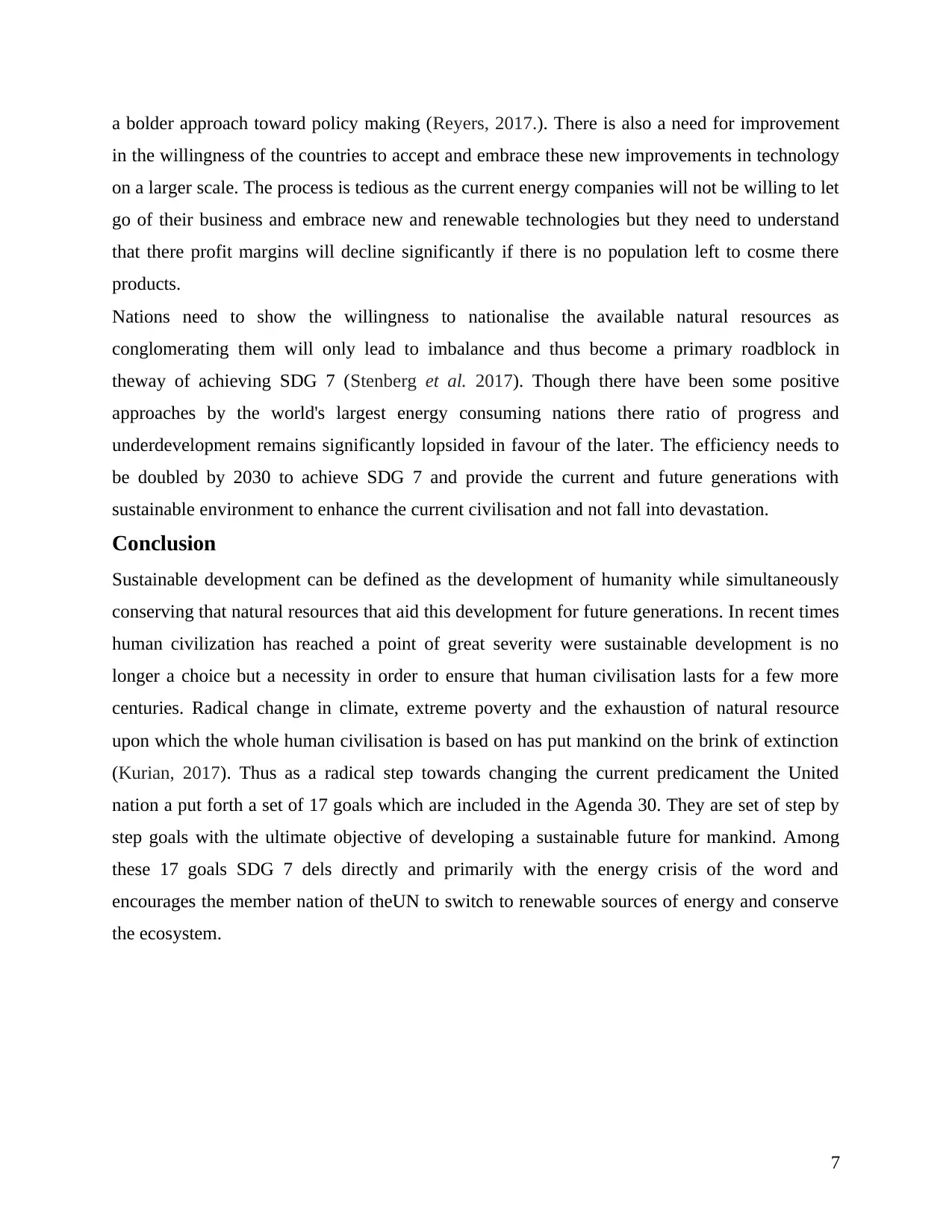
a bolder approach toward policy making (Reyers, 2017.). There is also a need for improvement
in the willingness of the countries to accept and embrace these new improvements in technology
on a larger scale. The process is tedious as the current energy companies will not be willing to let
go of their business and embrace new and renewable technologies but they need to understand
that there profit margins will decline significantly if there is no population left to cosme there
products.
Nations need to show the willingness to nationalise the available natural resources as
conglomerating them will only lead to imbalance and thus become a primary roadblock in
theway of achieving SDG 7 (Stenberg et al. 2017). Though there have been some positive
approaches by the world's largest energy consuming nations there ratio of progress and
underdevelopment remains significantly lopsided in favour of the later. The efficiency needs to
be doubled by 2030 to achieve SDG 7 and provide the current and future generations with
sustainable environment to enhance the current civilisation and not fall into devastation.
Conclusion
Sustainable development can be defined as the development of humanity while simultaneously
conserving that natural resources that aid this development for future generations. In recent times
human civilization has reached a point of great severity were sustainable development is no
longer a choice but a necessity in order to ensure that human civilisation lasts for a few more
centuries. Radical change in climate, extreme poverty and the exhaustion of natural resource
upon which the whole human civilisation is based on has put mankind on the brink of extinction
(Kurian, 2017). Thus as a radical step towards changing the current predicament the United
nation a put forth a set of 17 goals which are included in the Agenda 30. They are set of step by
step goals with the ultimate objective of developing a sustainable future for mankind. Among
these 17 goals SDG 7 dels directly and primarily with the energy crisis of the word and
encourages the member nation of theUN to switch to renewable sources of energy and conserve
the ecosystem.
7
in the willingness of the countries to accept and embrace these new improvements in technology
on a larger scale. The process is tedious as the current energy companies will not be willing to let
go of their business and embrace new and renewable technologies but they need to understand
that there profit margins will decline significantly if there is no population left to cosme there
products.
Nations need to show the willingness to nationalise the available natural resources as
conglomerating them will only lead to imbalance and thus become a primary roadblock in
theway of achieving SDG 7 (Stenberg et al. 2017). Though there have been some positive
approaches by the world's largest energy consuming nations there ratio of progress and
underdevelopment remains significantly lopsided in favour of the later. The efficiency needs to
be doubled by 2030 to achieve SDG 7 and provide the current and future generations with
sustainable environment to enhance the current civilisation and not fall into devastation.
Conclusion
Sustainable development can be defined as the development of humanity while simultaneously
conserving that natural resources that aid this development for future generations. In recent times
human civilization has reached a point of great severity were sustainable development is no
longer a choice but a necessity in order to ensure that human civilisation lasts for a few more
centuries. Radical change in climate, extreme poverty and the exhaustion of natural resource
upon which the whole human civilisation is based on has put mankind on the brink of extinction
(Kurian, 2017). Thus as a radical step towards changing the current predicament the United
nation a put forth a set of 17 goals which are included in the Agenda 30. They are set of step by
step goals with the ultimate objective of developing a sustainable future for mankind. Among
these 17 goals SDG 7 dels directly and primarily with the energy crisis of the word and
encourages the member nation of theUN to switch to renewable sources of energy and conserve
the ecosystem.
7
Paraphrase This Document
Need a fresh take? Get an instant paraphrase of this document with our AI Paraphraser
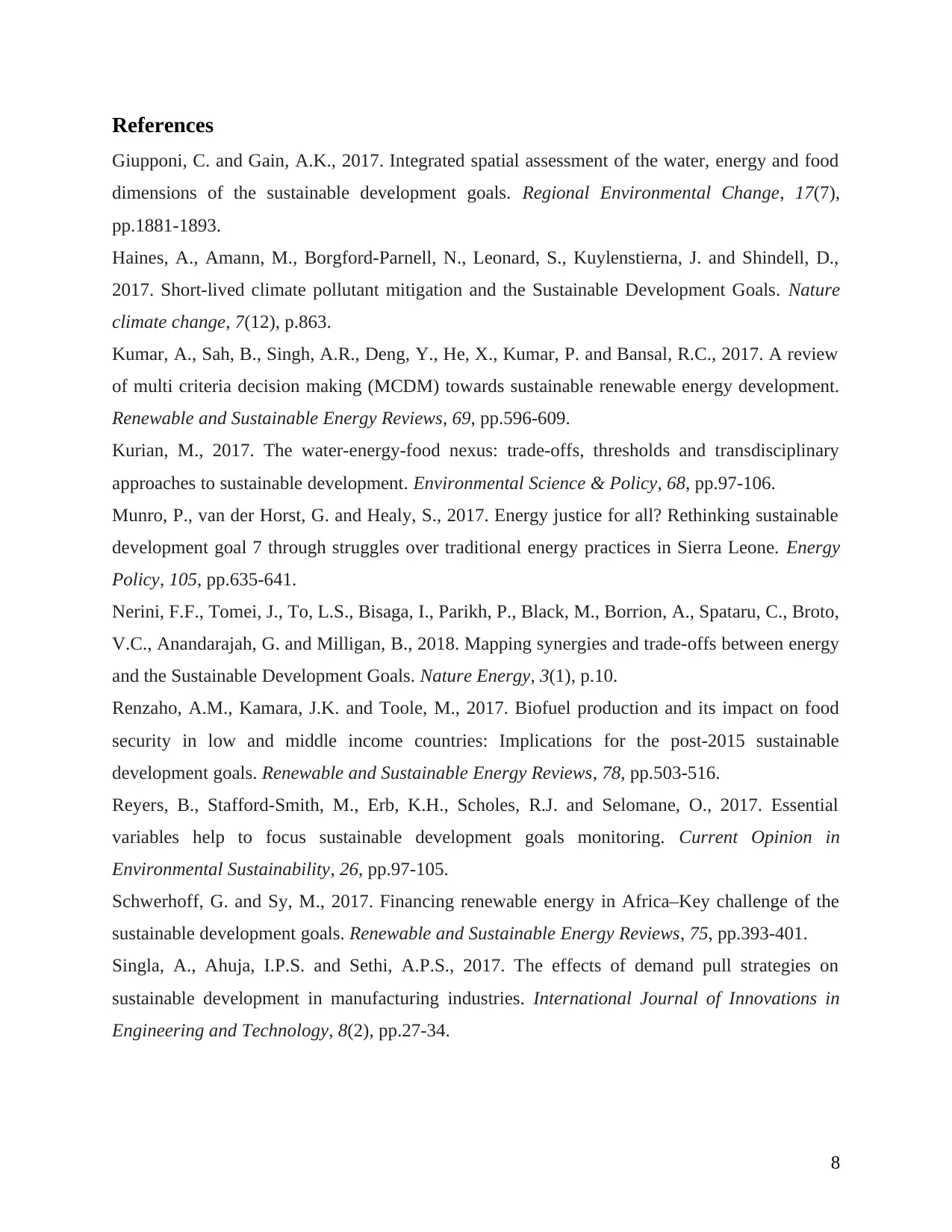
References
Giupponi, C. and Gain, A.K., 2017. Integrated spatial assessment of the water, energy and food
dimensions of the sustainable development goals. Regional Environmental Change, 17(7),
pp.1881-1893.
Haines, A., Amann, M., Borgford-Parnell, N., Leonard, S., Kuylenstierna, J. and Shindell, D.,
2017. Short-lived climate pollutant mitigation and the Sustainable Development Goals. Nature
climate change, 7(12), p.863.
Kumar, A., Sah, B., Singh, A.R., Deng, Y., He, X., Kumar, P. and Bansal, R.C., 2017. A review
of multi criteria decision making (MCDM) towards sustainable renewable energy development.
Renewable and Sustainable Energy Reviews, 69, pp.596-609.
Kurian, M., 2017. The water-energy-food nexus: trade-offs, thresholds and transdisciplinary
approaches to sustainable development. Environmental Science & Policy, 68, pp.97-106.
Munro, P., van der Horst, G. and Healy, S., 2017. Energy justice for all? Rethinking sustainable
development goal 7 through struggles over traditional energy practices in Sierra Leone. Energy
Policy, 105, pp.635-641.
Nerini, F.F., Tomei, J., To, L.S., Bisaga, I., Parikh, P., Black, M., Borrion, A., Spataru, C., Broto,
V.C., Anandarajah, G. and Milligan, B., 2018. Mapping synergies and trade-offs between energy
and the Sustainable Development Goals. Nature Energy, 3(1), p.10.
Renzaho, A.M., Kamara, J.K. and Toole, M., 2017. Biofuel production and its impact on food
security in low and middle income countries: Implications for the post-2015 sustainable
development goals. Renewable and Sustainable Energy Reviews, 78, pp.503-516.
Reyers, B., Stafford-Smith, M., Erb, K.H., Scholes, R.J. and Selomane, O., 2017. Essential
variables help to focus sustainable development goals monitoring. Current Opinion in
Environmental Sustainability, 26, pp.97-105.
Schwerhoff, G. and Sy, M., 2017. Financing renewable energy in Africa–Key challenge of the
sustainable development goals. Renewable and Sustainable Energy Reviews, 75, pp.393-401.
Singla, A., Ahuja, I.P.S. and Sethi, A.P.S., 2017. The effects of demand pull strategies on
sustainable development in manufacturing industries. International Journal of Innovations in
Engineering and Technology, 8(2), pp.27-34.
8
Giupponi, C. and Gain, A.K., 2017. Integrated spatial assessment of the water, energy and food
dimensions of the sustainable development goals. Regional Environmental Change, 17(7),
pp.1881-1893.
Haines, A., Amann, M., Borgford-Parnell, N., Leonard, S., Kuylenstierna, J. and Shindell, D.,
2017. Short-lived climate pollutant mitigation and the Sustainable Development Goals. Nature
climate change, 7(12), p.863.
Kumar, A., Sah, B., Singh, A.R., Deng, Y., He, X., Kumar, P. and Bansal, R.C., 2017. A review
of multi criteria decision making (MCDM) towards sustainable renewable energy development.
Renewable and Sustainable Energy Reviews, 69, pp.596-609.
Kurian, M., 2017. The water-energy-food nexus: trade-offs, thresholds and transdisciplinary
approaches to sustainable development. Environmental Science & Policy, 68, pp.97-106.
Munro, P., van der Horst, G. and Healy, S., 2017. Energy justice for all? Rethinking sustainable
development goal 7 through struggles over traditional energy practices in Sierra Leone. Energy
Policy, 105, pp.635-641.
Nerini, F.F., Tomei, J., To, L.S., Bisaga, I., Parikh, P., Black, M., Borrion, A., Spataru, C., Broto,
V.C., Anandarajah, G. and Milligan, B., 2018. Mapping synergies and trade-offs between energy
and the Sustainable Development Goals. Nature Energy, 3(1), p.10.
Renzaho, A.M., Kamara, J.K. and Toole, M., 2017. Biofuel production and its impact on food
security in low and middle income countries: Implications for the post-2015 sustainable
development goals. Renewable and Sustainable Energy Reviews, 78, pp.503-516.
Reyers, B., Stafford-Smith, M., Erb, K.H., Scholes, R.J. and Selomane, O., 2017. Essential
variables help to focus sustainable development goals monitoring. Current Opinion in
Environmental Sustainability, 26, pp.97-105.
Schwerhoff, G. and Sy, M., 2017. Financing renewable energy in Africa–Key challenge of the
sustainable development goals. Renewable and Sustainable Energy Reviews, 75, pp.393-401.
Singla, A., Ahuja, I.P.S. and Sethi, A.P.S., 2017. The effects of demand pull strategies on
sustainable development in manufacturing industries. International Journal of Innovations in
Engineering and Technology, 8(2), pp.27-34.
8
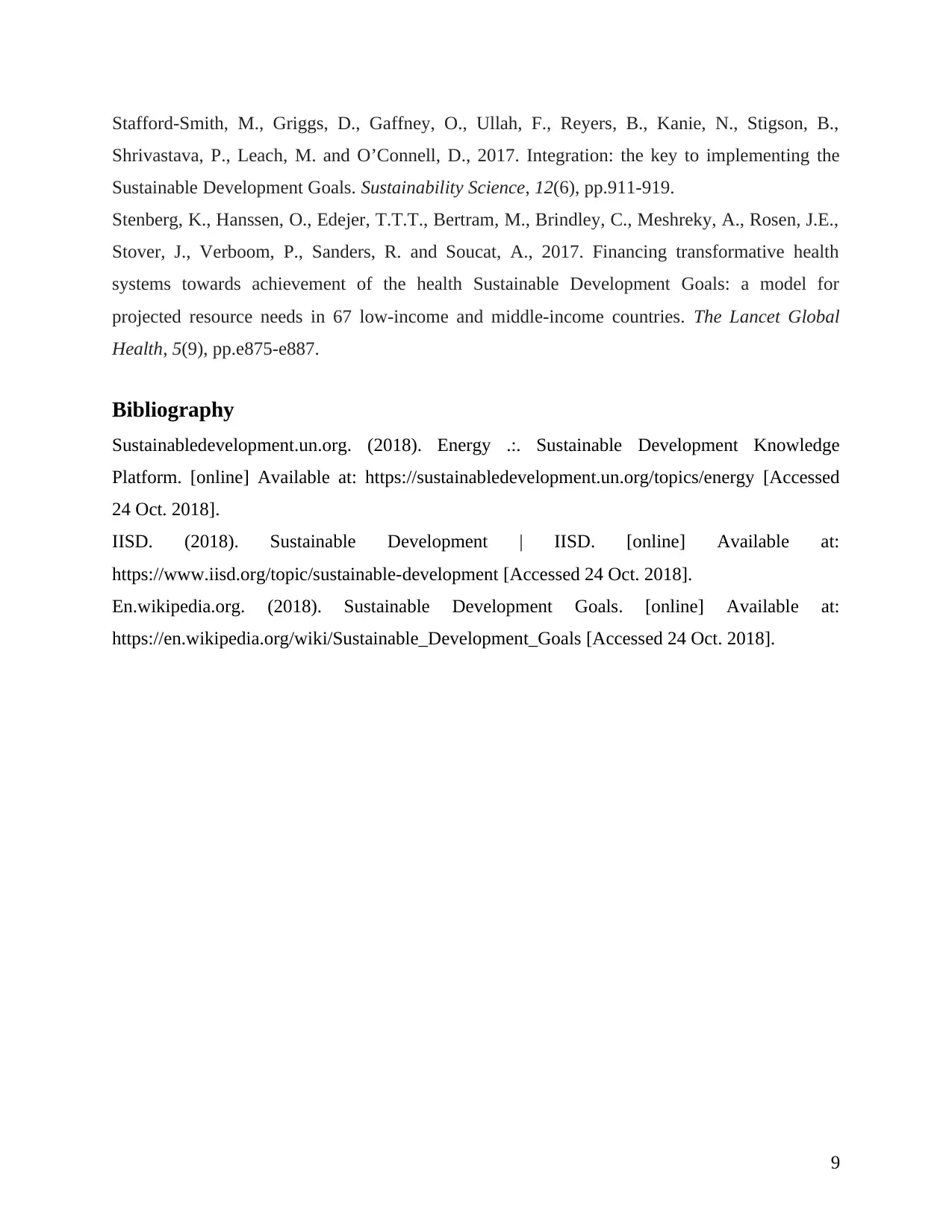
Stafford-Smith, M., Griggs, D., Gaffney, O., Ullah, F., Reyers, B., Kanie, N., Stigson, B.,
Shrivastava, P., Leach, M. and O’Connell, D., 2017. Integration: the key to implementing the
Sustainable Development Goals. Sustainability Science, 12(6), pp.911-919.
Stenberg, K., Hanssen, O., Edejer, T.T.T., Bertram, M., Brindley, C., Meshreky, A., Rosen, J.E.,
Stover, J., Verboom, P., Sanders, R. and Soucat, A., 2017. Financing transformative health
systems towards achievement of the health Sustainable Development Goals: a model for
projected resource needs in 67 low-income and middle-income countries. The Lancet Global
Health, 5(9), pp.e875-e887.
Bibliography
Sustainabledevelopment.un.org. (2018). Energy .:. Sustainable Development Knowledge
Platform. [online] Available at: https://sustainabledevelopment.un.org/topics/energy [Accessed
24 Oct. 2018].
IISD. (2018). Sustainable Development | IISD. [online] Available at:
https://www.iisd.org/topic/sustainable-development [Accessed 24 Oct. 2018].
En.wikipedia.org. (2018). Sustainable Development Goals. [online] Available at:
https://en.wikipedia.org/wiki/Sustainable_Development_Goals [Accessed 24 Oct. 2018].
9
Shrivastava, P., Leach, M. and O’Connell, D., 2017. Integration: the key to implementing the
Sustainable Development Goals. Sustainability Science, 12(6), pp.911-919.
Stenberg, K., Hanssen, O., Edejer, T.T.T., Bertram, M., Brindley, C., Meshreky, A., Rosen, J.E.,
Stover, J., Verboom, P., Sanders, R. and Soucat, A., 2017. Financing transformative health
systems towards achievement of the health Sustainable Development Goals: a model for
projected resource needs in 67 low-income and middle-income countries. The Lancet Global
Health, 5(9), pp.e875-e887.
Bibliography
Sustainabledevelopment.un.org. (2018). Energy .:. Sustainable Development Knowledge
Platform. [online] Available at: https://sustainabledevelopment.un.org/topics/energy [Accessed
24 Oct. 2018].
IISD. (2018). Sustainable Development | IISD. [online] Available at:
https://www.iisd.org/topic/sustainable-development [Accessed 24 Oct. 2018].
En.wikipedia.org. (2018). Sustainable Development Goals. [online] Available at:
https://en.wikipedia.org/wiki/Sustainable_Development_Goals [Accessed 24 Oct. 2018].
9
⊘ This is a preview!⊘
Do you want full access?
Subscribe today to unlock all pages.

Trusted by 1+ million students worldwide
1 out of 9
Related Documents
Your All-in-One AI-Powered Toolkit for Academic Success.
+13062052269
info@desklib.com
Available 24*7 on WhatsApp / Email
![[object Object]](/_next/static/media/star-bottom.7253800d.svg)
Unlock your academic potential
Copyright © 2020–2025 A2Z Services. All Rights Reserved. Developed and managed by ZUCOL.


